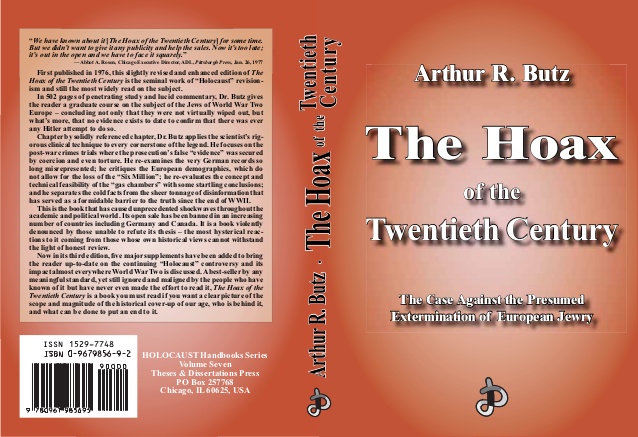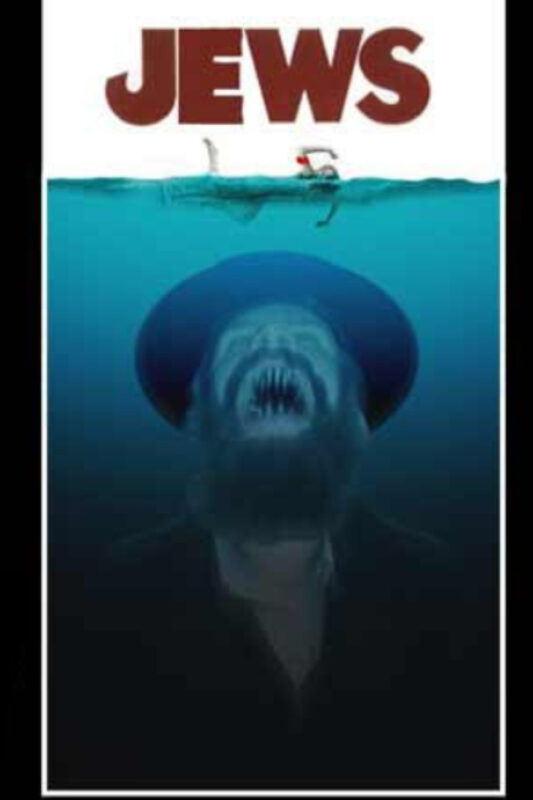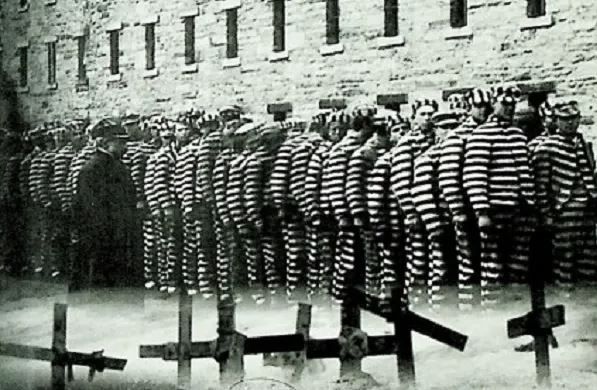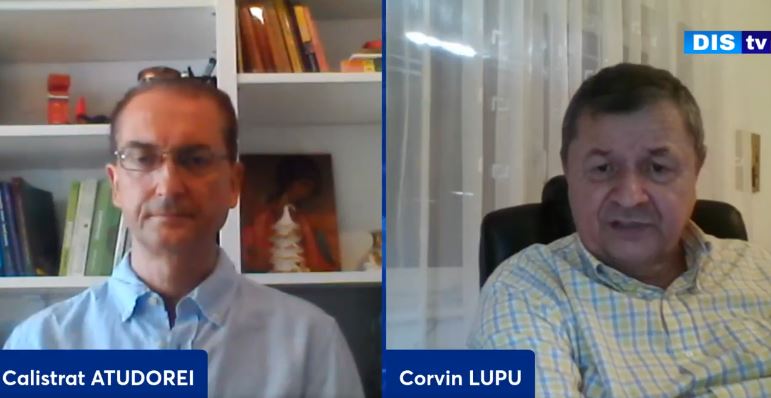Incorect Politic
August 30, 2020
ÎNŞELĂTORIA SECOLULUI XX (50)
ARTHUR ROBERT BUTZ
Episoadele 1, 2, 3, 4, 5, 6, 7, 8, 9, 10, 11, 12, 13, 14, 15, 16, 17,18,19, 20, 21, 22, 23, 24, 25, 26, 27, 28, 29,30,31,32,33, 34, 35, 36, 37,38, 39, 40, 41, 42, 43, 44, 45, 46, 47, 48, 49
Înșelătoria Secolului XX (50)
BIBLIOGRAFIA GENERALĂ
După ediţia americană din 2003
References
Arthur R. Butz, THE HOAX OF THE TWENTIETH CENTURY. The Case Against the Presumed Extermination of European Jewry, Theses & Dissertations Press, PO Box 257768, Chicago, Illinois 60625, September 2003, pag. 484-491.
- Actes et documents du Saint Siège relatifs à la seconde guerre mondiale, 11 vols., Libreria Editrice Vaticana, Vatican City, 1967-1974.
- Stephen E. Ambrose, ed., Handbook On German Military Forces, Louisiana State Univ. Press, Baton Rouge, 1990.
- L. S. Amery, general editor, The Times History of the War in South Africa, 7 vols., Sampson Low, Marston & Co., London, 1907 (vol. 5), 1909 (vol. 6).
- Burton C. Andrus, I Was the Nuremberg Jailer, Coward-McCann, New York, 1969.
- Anonymous (David L. Hoggan), The Myth of the Six Million, Noontide Press, Los Angeles, 1969.
- Jacob Apenszlak, ed., The Black Book of Polish Jewry, American Federation for Polish Jews, 1943.
- Austin J. App, The Six Million Swindle, Boniface Press, 8207 Flower Ave., Takoma Park, Md. 20012. 1973.
- Hannah Arendt, Eichmann in Jerusalem: A Report on the Banality of Evil, Viking, New York, 1963 (revised and enlarged edition in 1964).9. Emil Aretz, Hexen-Einmal-Eins einer Lüge, 3rd., Verlag Hohe Warte – Franz von Bebenburg, München, 1973.
- Eugène Aronéanu, ed., Camps de Concentration, Service d’Information des Crimes de Guerre Paris, 1946.
- John Clive Ball, Air Photo Evidence, Ball Resource Service Ltd., Delta, BC, 1992.
- Bryan Ballantyne, Timothy C. Marrs (eds.), Clinical and Experimental Toxicology of Cyanides, Wright, Bristol, 1987.
- Maurice Bardèche, Nuremberg II, ou Les Faux Monnayeurs, Les Sept Couleurs, Paris, 1950.
- Harry Elmer Barnes, “The Public Stake in Revisionism“, Rampart J. of Individualist Thought, vol. 3, no. 2 (Summer 1967), 19-41.
- Yehuda Bauer, American Jewry and the Holocaust, Wayne State University Press, Detroit, 1981.
- John Beaty, The Iron Curtain Over America, Wilkinson Publishing, Dallas, Texas, 1951.
- R. L. Bebb & L. B. Wakefield, “German Synthetic Rubber Developments” in G. S. Whitby, C. C.
- Davis & R. F. Dunbrook, eds., Synthetic Rubber, 937-986, John Wiley, New York and Chapman & Hall, London, 1954.
- Montgomery Belgion, Victor’s Justice, Henry Regnery, Hinsdale, Illinois, 1949.
- Paul Berben, Dachau 1933-1945: The Official History, Norfolk Press, London, 1975.
- Ted Berkman, Cast a Giant Shadow, Doubleday, Garden City, New York, 1962.
- Jadwiga Bezwinska, ed., KL Auschwitz Seen by the SS, Howard Fertig, NY, 1984.
- Bibliography of the Holocaust and After, Israel Book and Printing Center, Tel Aviv.
- John Morton Blum, From the Morgenthau Diaries. Years of War 1941-1945 (3rd vol. in a series), Houghton Mifflin, Boston, 1967.
- Nachmann Blumental, ed., Dokumenty i Materialy, vol. 1, Obozy (Camps) Wydawnictwa Centralnej Zydowskiej Komisji Historycznej, Lodz, 1946.
- Eric H. Boehm, ed., We Survived, Yale University Press, New Haven, 1949.
- Michel Borwicz, Écrits des Condamnés à Mort Sous l’Occupation Allemende, Presses Universitaires de France, Paris, 1954.
- Randolph A. Braham, ed., The Destruction of Hungarian Jewry, 2 vols., Pro Arte, New York, 1963.
- H. Breymesser and E. Bernfus, eds., Blausäuregaskammern zur Fleckfieberabwehr, Reichsarbeitsblatt, Berlin, 1943.
- Brown Book: War and Nazi Criminals in West Germany, Verlag Zeit im Bild, Berlin (DDR), 1965. Listed title may not include words “Brown Book”.
- Dino A. Brugioni and Robert G. Poirier, The Holocaust Revisited: A Retrospective Analysis of the Auschwitz-Birkenau Extermination Complex, Public Affairs Office, Central Intelligence Agency, Washington, DC, 1979.
- Margaret Buber, Under Two Dictators, Dodd, Mead & Co., New York.
- Howard A. Buechner, Dachau. The Hour of the Avenger. An Eyewitness Account, Metairie, LA, Thunderbird Press, 1986
- Bundesministerium der Finanzen (ed.), Entschädigung von NS-Unrecht, Berlin 2002.
- J. G. Burg, Schuld und Schicksal, Damm Verlag, München, 1962.
- J. G. Burg, Sündenböcke, G. Fischer, München, 1967.
- J. G. Burg, NS-Verbrechen, G. Fischer, München, 1968.
- Christopher Burney, The Dungeon Democracy, Duell, Sloan & Pearce, New York, 1946.
- Edouard Calic, Secret Conversations with Hitler, John Day, New York, 1971.
- Cambridge Ancient History, various editors, 12 vols., 1st ed., Cambridge, 1923-1939.
- Jérome Carcopino, Daily Life in Ancient Rome, Yale, New Haven, 1940.
- Kit C. Carter and Robert Mueller, The Army Air Forces in World War II – Combat Chronology – 1941-1945, Albert F. Simpson Historical Research Center, Air University, and Office of Air Force History, 1973. Superintendent of Documents stock number 0870-00334.
- Central Commission for Investigation of German Crimes in Poland, German Crimes in Poland, vol. 1, Warsaw, 1946.
- William Henry Chamberlin, America’s Second Crusade, Henry Regnery, Chicago, 1950.
- Thies Christophersen, Die Auschwitz Lüge, 2nd ed., Kritik-Verlag, Mohrkirch, 1973. English translation from Western Unity Movement, P.O. Box 156, Verdun 19, Quebec, Canada, 1974.
- Elie A. Cohen, Human Behavior in the Concentration Camp, W. W. Norton, New York, 1953.
- Margaret L. Coit, Mr. Baruch, Riverside Press, Cambridge, Massachusetts, 1957.
- Benjamin Colby, ‘Twas a Famous Victory, Arlington House, New Rochelle, New York, 1974.
- Christopher Bush Coleman, Constantine the Great and Christianity, Columbia University Press, New York, 1914.
- Christopher Bush Coleman, The Treatise of Lorenzo Valla on the Donation of Constantine, Yale University Press, New Haven, 1922.
- Ian Colvin, Master Spy, McGraw-Hill, New York, 1951.
- Robert Conquest, The Great Terror, Macmillan, New York, 1968.
- Vesley Frank Craven, James Lea Cate & USAF Historical Div., eds., The Army Air Forces in World War II, vol. 3, University of Chicago, 1951.
- Danuta Czech, Auschwitz Chronicle,1939-1945, Henry Holt, New York, 1990.
- Eugene Davidson, The Trial of the Germans, Macmillan, New York, 1966.
- K. Dau, Über Kanalvergasungen und ihre Verhütung, Dissertationsdruckerei und Verlag Konrad Triltsch, Würzburg, 1935.
- Maurice R. Davie, Refugees in America, Harper, New York, 1947.
- Lucy S. Dawidowicz, The War Against the Jews, 1933-1945, Holt, Rinehart and Winston, New York, 1975.
- Lucy S. Dawidowicz, The Holocaust and the Historians, Harvard University Press, Cambridge, 1981.
- Andrea Devoto Bibliografia dell’Oppressione Nazista Fino al 1962, Leo S. Olschki, Firenze, 1964.
- Alexander Donat, ed., The Death Camp Treblinka, Holocaust Library, New York, 1979.
- Quincy L. Dowd, Funeral Management and Costs, University of Chicago, 1921.
- Josiah E. DuBois, Jr., The Devil’s Chemists, Beacon Press, Boston, 1952.
- R. F. Dunbrook, “Historical Review” in G. S. Whitby et al. (see Bebb and Wakefield above), 32-55.
- Debórah Dwork and Robert Jan van Pelt, Auschwitz, 1270 to the Present, W.W. Norton, NY, 1996.
- Adolf Eichmann, The Attorney-General of the Government of Israel vs. Adolf, the Son of Adolf Karl Eichmann, Minutes of Sessions, Jerusalem, 1962.
- Encyclopedia Britannica, 12 ed., vol. 32, 1922 – third volume supplementing the 11th ed.
- Encyclopedia Judaica, 16 vols., Keter Pub. House, Jerusalem, and Macmillan, New York, 1971.
- Isidore Epstein, ed., The Talmud (Babylonian), many vols., Soncino Press, London, 1936.
- Henry L. Feingold, The Politics of Rescue, Rutgers University Press, New Brunswick, NJ, 1970.
- Jean-François Forges, Éduquer contre Auschwitz, ESF, Paris, 1997.
- John F. Foster and Richard J. Lund, eds., Economics of Fuel Gas from Coal, McGraw Hill, New York, 1950.
- Anne Frank, Diary of a Young Girl, Doubleday, Garden City, New York, 1952.
- Tenney Frank, ed., An Economic Survey of Ancient Rome, 6 vols., Johns Hopkins, Baltimore, 1933-1940.
- Hermann Franke, ed., Lueger. Lexikon der Technik, Deutsche Verlags-Anstalt, Stuttgart, 1960-1972.
- Saul Friedlaender, Kurt Gerstein: The Ambiguity of Good, Alfred A. Knopf, New York, 1969.
- Filip (or Philip) Friedman, This was Oswiecim: The story of a murder camp, United Jewish Relief Appeal, London, 1946.
- Philip Friedman and Koppel S. Pinson, “Some Books on the Jewish Catastrophe“, Jewish Social Studies, (January 1950), 83-94.
- Gregory (Grzegorz) Frumkin, Population Changes in Europe Since 1939, George Allen & Unwin, London, and Augustus M. Kelley, New York, 1951.
- Alexander Fuks, “Aspects of the Jewish Revolt in A.D. 115-117“, J. Roman Studies, vol. 51, 1961, 98-104.
- Ernst Gauss (ed.), Grundlagen zur Zeitgeschichte: Ein Handbuch über strittige Fragen des 20. Jahrhunderts, Grabert-Verlag, Tübingen, 1994.
- G. M. Gilbert, Nuremberg Diary, Farrar, Strauss & Co., New York, 1947.
- Martin Gilbert, Auschwitz and the Allies, Holt, Rinehart and Winston, New York, 1981.
- Jacob Glatstein, Israel Knox and Samuel Margoshes, eds., Anthology of Holocaust Literature, Jewish Pub. Society of America, Philadelphia, 1969.
- John E. Gordon, „Louse-Borne Typhus Fever in the European Theater of Operations, US Army, 1945“, in Forest Ray Moulton, ed., Rickettsial Diseases of Man, Am. Acad. for the Advancement of Science, Washington, DC, 1948, 16-27.
- Wigbert Grabert (ed.), Geschichtsbetrachtung als Wagnis, Grabert, Tübingen, 1984.
- Jürgen Graf, The Giant with Feet of Clay, Theses & Dissertations Press, Capshaw, AL, 2001.
- Michael Grant, The Jews in the Roman World, Weidenfeld and Nicolson, London, 1973.
- Solomon Grayzel, A History of the Jews, Jewish Pub. Society of America, Philadelphia, 1947.
- Samuel Gringauz, “The Ghetto as an Experiment of Jewish Social Organization“, Jewish Social Studies, (January 1949), 3-20.
- Samuel Gringauz, “Some Methodological Problems in the Study of the Ghetto“, Jewish Social Studies, (January 1950), 65-72.
- Nerin E. Gun, The Day of the Americans, Fleet Pub. Corp., 1966.
- Y. Gutman and M. Berenbaum, eds., Anatomy of the Auschwitz Death Camp, Indiana University Press, Bloomington, 1994.
- William A. Hardenbergh, “Research Background of Insect and Rodent Control“, in Preventive Medicine in World War II, vol. II, Environmental Hygiene, John Boyd Coates, Jr. & Ebbe Curtis Hoff, eds., Office of the Surgeon General, Washington, DC, 1955, 251.
- Richard Harwood, Did Six Million Really Die?, Historical Review Press, Richmond, Surrey, 1974.
- William Best Hesseltine, Civil War Prisons, Ohio State University Press, Columbus, 1930.
- Raul Hilberg, The Destruction of the European Jews, Quadrangle Books, Chicago, 1961 & 1967.
- Raul Hilberg, The Destruction of the European Jews, Holmes & Meier [3 vols.], New York, 1985.
- Adolf Hitler, My New Order, Raoul de Roussy de Sales, ed., Reynal & Hitchcock, New York, 1941.
- Heinz Höhne, The Order of the Death’s Head, tr. by Richard Barry, Ballantine Books, New York, 1971.
- Frank A. Howard, Buna Rubber: The Birth of an Industry, D. Van Nostrand, New York, 1947.
- Cordell Hull, Memoirs, vol. 1, Macmillan, New York, 1948.
- K. Imhoff, Taschenbuch der Stadtentwässerung, 10th ed., Munich and Berlin, 1943.
- IMT (International Military Tribunal), Trial of the Major War Criminals, IMT, Nuremberg, 42 vols., 1947-1949. May be listed under “US Army Civil Affairs Division. Trial of the major war criminals […] ”
- Internationales Buchenwald-Komitee, Buchenwald, Roederberg-Verlag, Frankfurt, 1960.
- Fred L. Israel, ed., The War Diary of Breckinridge Long, University of Nebraska Press, Lincoln, 1966.
- Eberhard Jaeckel, Hitler’s Weltanschauung, Wesleyan University Press, Middletown, Connecticut, 1972.
- Robert John & Sami Hadawi, The Palestine Diary, 2 vols., New World Press, New York, 1970.
- Allen J. Johnson & George H. Auth, Fuels and Combustion Handbook, First ed., McGraw-Hill, New York, 1951.
- Louis de Jong, “Die Niederlande und Auschwitz“, Vierteljahrshefte für Zeitgeschichte, vol. 17, no. 1 (January 1969), 1-16. In English translation in Yad Vashem Studies, vol. 7, 39 – 55.
- Jürgen Kalthoff, Martin Werner, Die Händler des Zyklon B, VSA-Verlag, Hamburg 1998
- Douglas M. Kelley, 22 Cells in Nuremberg, Greenberg, New York, 1947.
- Robert M. W. Kempner, Nazi Subversive Organization, Past and Future, stencil, privately published, October 30, 1943.
- John F. Kennedy, Profiles in Courage, Harper, New York, 1955. Memorial edition 1964.
- Jon Kimche & David Kimche, The Secret Roads, Farrar, Straus & Cudahy, New York, 1955. Introduction by David Ben-Gurion.
- E. F. Knipling, “DDT and Other Insecticides for the Control of Lice and Fleas Attacking Man“, in Moulton (see Gordon), 215-223.
- Robert L. Koehl, RKFDV: German Resettlement and Population Policy 1939-1945, Harvard University Press, Cambridge, Massachusetts, 1957.
- E. Kogon, et al., Nationalsozialistische Massentötungen durch Giftgas, Fischer, Frankfurt/M., 1986.
- E. Kogon, et al., Nazi Mass Murder: A Documentary History of the Use of Poison Gas, Yale University Press, New Haven, Connecticut, 1994.
- Morris W. Kolander, “War Crimes Trials in Germany“, Pennsylvania Bar Assn. Quarterly, vol. 18, (April 1947), 274-280.
- Komitee der Antifaschistischen Widerstandskämpfer in der DDR, Sachsenhausen, Kongress-Verlag, Berlin, 1962.
- Leszek A. Kosinski, “Changes in the Ethnic Structure of East Central Europe, 1930-1960“, Geographical Review, vol. 59, 1969, 388-402. Also “Migration of Population in East-Central Europe, 1939-1955“, Canadian Slavonic Papers, vol. 11, 1969, 357-373.
- Helmut Krausnick, Hans Buchheim, Martin Broszat & Hans-Adolf Jacobsen, The Anatomy of the SS State, Walker, New York, 1968.
- H. Kretzschmar, Technische Mikrobiologie, Berlin and Hamburg, 1968.
- Hermann Langbein, Der Auschwitz Prozess. Eine Dokumentation, 2 vols., Europa Verlag, Wien, 1965.
- J. Länik, Co Dante nevidel, Bratislava, 1964.
- J. Länik, Was Dante nicht sah, Die Buchgemeinde, Vienna, 1964.
- Walter Laqueur, The Terrible Secret, Little, Brown & Co., Boston, 1980.
- Walter Laqueur, Richard Breitman, Breaking the Silence, Simon & Schuster, New York 1986.
- Hans Laternser, Die andere Seite im Auschwitz Prozess 1963/65, Seewald Verlag, Stuttgart, 1966.
- Johann M. Lenz, Christ in Dachau (tr. Countess Barbara Waldstein), Missionsdruckerei St. Gabriel, Moedling bei Wien, 1960.
- A. A. Lepinga and N.P. Strakhovoi, eds., Nemetsko-Russkii Slovar, Sov. Entsiklopediia, Moscow, 1968.
- Daniel Lerner, Psychological Warfare Against Nazi Germany, MIT Press, Cambridge, Massachusetts, 1971.
- Fred A. Leuchter, An Engineering Report on the alleged Execution Gas Chambers at Auschwitz, Birkenau and Majdanek, Poland, Samisdat Publishers Ltd., Toronto, 1988.
- Louis P. Lochner, ed., The Goebbels Diaries, Doubleday, Garden City, New York, 1948. Republished by Greenwood Press, Westport, Connecticut, 1970.
- David Marcus, “War Crimes” article in Britannica Book of the Year – 1947, 819-821, Encyclopedia Britannica, Chicago.
- Hans Marsálek, Die Geschichte des Konzentrationslagers Mauthausen, Vienna, 1974.
- James J. Martin, Revisionist Viewpoints, Ralph Myles, Colorado Springs, 1971.
- Carlo Mattogno, Jürgen Graf, Treblinka – Extermination Camp or Transit Camp?, Theses & Dis sertations Press, Chicago 2003.
- Arno J. Mayer, Why did the Heavens not Darken? The ‘Final Solution’ in History, Pantheon Books, New York 1990.
- C. C. McCown, “The Density of Population in Ancient Palestine“, J. Biblical Lit., vol. 66, 1947, 425-436.
- James G. McDonald, My Mission in Israel, Simon & Schuster, New York, 1951.
- McGraw-Hill Encyclopedia of Science and Technology, 7th edition, 1992.
- Metcalf and Eddy, Inc., Wastewater Engineering, 3rd ed., 1991.
- Jules Michelet, Satanism and Witchcraft, Citadel Press, New York, 1939.
- Henry Morgenthau, Jr., “The Morgenthau Diaries – Part VI“, Collier’s (November 1, 1947), 22+.
- Morgenthau Diary (Germany), 2 vols. published by US Senate Committee on the Judiciary, US Government Printing Office, Washington, DC, November 20, 1967.
- Superintendent of Documents nos. Y4.J 89/2:M 82/2/v. 1 and v. 2. The book Das Morgenthau Tagebuch, ed. Hermann Schild, Druffel-Verlag, Leoni am Starnberger See, 1970, consists mainly of excerpts from the two volumes, translated into German.
- Arthur D. Morse, While Six Million Died, Random House, New York, 1968.
- George L. Mosse, The Crisis of German Ideology, Grosset and Dunlap, New York, 1964. Printing of 1971.
- Filip Müller, Eyewitness Auschwitz, Stein and Day, NY, 1979.
- Teodor Musiol, Dachau, 1933-1945, Instytut Slaski w Opulo, Katowice.
- Dillon S. Meyer, Uprooted Americans, University of Arizona Press, Tucson, 1971.
- Bernd Naumann, Auschwitz (tr. Jean Steinberg), Frederick A. Praeger, New York, 1966. Original German edition from Athenaeum Verlag, Frankfurt, 1965.
- W. J. S. Naunton, “Synthetic Rubber” in History of the Rubber Industry, P. Schidrowitz & T.R. Dawson, eds., pub. for The Institute of the Rubber Industry by W. Heffer & Sons Ltd., Cambridge, UK, 1952, 100-109.
- Netherlands Red Cross, Auschwitz, Hoofdbestuur van de Vereniging het Nederlandsche Roode Kruis, 6 vols., The Hague, 1947-1953.
- Oskar Neumann (or J. Oskar Neumann), Im Schatten des Todes, Tel-Aviv, 1956.
- Francis R. Nicosia, The Third Reich and the Palestine Question, 2nd ed., Transaction Publishers, New Brunswick 1999.
- NMT (Nuremberg Military Tribunal), Trials of War Criminals, US Government Printing Office, Washington, DC, 1950, 15 vols. May be listed under “US Defense Dept., Adjutant General. Trials of war criminals […]”.
- Miklos Nyiszli, Auschwitz, Frederick Fell, New York, 1960.
- Terence H. O’Brien, Civil Defence, H.M. Stationery Office and Longmans, London, 1955.
- Oswiecim. Camp of Death, Poland Fights, New York, 1944.
- James E. Packer, “Housing and Population in Imperial Ostia and Rome“, J. Roman Studies, vol. 57, 1967, 80-95.
- O. Pallasch and W. Triebel, eds., Lehr- und Handbuch der Abwassertechnik, Berlin and Munich, 1969.
- L. F. Parparov, ed., Nemetsko-Russkii Voennyi Slovar, Voenizdat, Moscow, 1964.
- Jean Pélissier, Camps de la Mort, Éditions Mellottée, Paris, 1946.
- Raymond Phillips, ed., Trial of Josef Kramer and Forty-Four Others (The Belsen Trial), William Hodge, London, 1949.
- Léon Poliakov & Josef Wulf, Das Dritte Reich und die Juden, Arani-Verlags, Berlin-Grunewald, 1955.
- Léon Poliakov & Josef Wulf, Das Dritte Reich und Seine Diener, Arani-Verlags, Berlin-Grunewald, 1956.
- C. J. Polson, R. P. Brittain & T. K. Marshall, Disposal of the Dead, 2nd ed., Charles C. Thomas, Springfield, Illinois, 1962.
- A. M. Prentiss, Chemicals in War, McGraw-Hill, New York, 1937.
- Jean-Claude Pressac, Auschwitz: Technique and Operation of the Gas Chambers, Beate Klarsfeld Foundation, New York, 1989. The reader should understand that the title of this book is misleading, as the only real “gas chambers” whose “technique and operation” are discussed are fumigation gas chambers. The homicidal gas chambers are only imagined, based on alleged “criminal traces.” This book is the greatest single published source of reproductions of original documents and photographs for the camp.
- Jean-Claude Pressac, Les Crématoires d’Auschwitz: La Machinerie du Meurtre de Masse, CNRS Éditions, Paris, 1993. The reader should understand that the title of this book is misleading, as it does not treat any machinery of mass murder.
- Terrence Prittie, Eshkol: The Man and the Nation, Pitman, New York, 1969.
- F. Puntigam et al., Blausäure Gaskammern zur Fleckfieber Abwehr, Reichsarbeitsblattes, Berlin, 1943.
- F. Puntigam, H. Breymesser and E. Bernfus, Blausäure Gaskammern zur Fleckfieber Abwehr, Reichsarbeitsblatt (special publication), Reichsarbeitsministerium, Berlin, 1943.
- Hermann Raschhofer, Political Assassination, Fritz Schlichtenmayer, Tübingen, 1964.
- Paul Rassinier, Le Mensonge d’Ulysse, 5th ed., La Librairie Française, Paris, 1961. English translation Debunking the Genocide Myth, Noontide Press, Torrance, CA, 1978. Subsequently republished by the Institute for Historical Review under the title, The Holocaust Story and the Lies of Ulysses.
- Paul Rassinier, Ulysse Trahi par les siens, La Librairie Française, Paris, 1961 (not referenced on any specific point here).
- Paul Rassinier, Le Véritable Procès Eichmann, Les Sept Couleurs, Paris, 1962. German translation Zum Fall Eichmann: Was ist Warheit?, Druffel-Verlag, Leoni am Starnberger See, 1963. English translation The Real Eichmann Trial, Historical Review Press, Southam, UK, 1979.
- Paul Rassinier, Le Drame des Juifs Européens, Les Sept Couleurs, Paris, 1964. German translation Das Drama der Juden Europas, Hans Pfeiffer Verlag, Hanover, 1965. English translation Drama of the European Jews, Steppingstones Publications, Silver Spring, Maryland 20901, 1975.
- Paul Rassinier, L’Opération Vicaire, La Table Ronde, Paris, 1965.
- Paul Rassinier, Debunking the Genocide Myth, Institute for Historical Review, Torrance 1978.
- Red Cross. International Documents sur l’activité du CICR en faveur des civils détenus dans les camps de concentration en Allemagne (1939-1945), Geneva, 1947.
- Red Cross. International. Report of the International Committee of the Red Cross on its Activities During the Second World War (Sept 1, 1939-June 30, 1947), 3 vols., Geneva, 1948.
- Gerald Reitlinger, The Final Solution, 2nd ed., Vallentine, Mitchell, London, 1968.
- Anthony Rhodes, The Vatican in the Age of the Dictators 1922-1945, Hodder and Stoughton, London, 1973.
- Wilmot Robertson, The Dispossessed Majority, Howard Allen, Cape Canaveral, Florida, 1972. Revised 1973.
- Henri Roques, The “Confessions” of Kurt Gerstein, Institute for Historical Review, Costa Mesa, California, 1989.
- Samuel I. Rosenman, Working With Roosevelt, Harper, New York, 1952.
- Wolf Dieter Rothe, Die Endlösung der Judenfrage, Band 1, Zeugen, E. Bierbaum Verlag, Frankfurt, 1974.
- Hans Rothfels, The German Opposition to Hitler, Henry Regnery, Chicago, 1962.
- Adalbert Rückerl, ed., Nationalsozialistische Vernichtungslager im Spiegel deutscher Strafprozesse, Deutscher Taschenbuch Verlag, Munich, 1977.
- Germar Rudolf (ed.), Dissecting the Holocaust: The Growing Critique of “Truth” and “Memory”, 2nd edition, Theses & Dissertations Press, Chicago, 2003.
- Germar Rudolf, The Rudolf Report. Expert Report on Chemical and Technical Aspects of the ‘Gas Chambers’ of Auschwitz, Theses & Dissertations Press, Chicago, 2003.
- Arthur Ruppin, The Jewish Fate and Future, Macmillan, London, 1940.
- C.F. Rüter et al. (ed.), Justiz und NS-Verbrechen, 28 vols. & reg., University Press, Amsterdam/APA Holland University Press, Amsterdam/Saur, München 1968-2003.
- Abram Leon Sachar, The History of the Jews, 5th ed., Alfred A. Knopf, New York, 1964.
- Walter N. Scanning, The Dissolution of Eastern European Jewry, IHR, Newport Beach, California, 1983.
- Paul Schmidt, Hitler’s Interpreter, William Heinemann, London, 1951.
- Raimund Schnabel, Macht ohne Moral, Frankfurt/ Main, 1957.
- Gerhard Schoenberner, The Yellow Star, Transworld, London, 1969. Also in paperback from Bantam, New York, 1969. Originally published in German as Der Gelbe Stern, 1960 & 1969.
- Select Committee to Conduct an Investigation of the Facts, Evidence, and Circumstances of the Katyn Forest Massacre, The Katyn Forest Massacre, part 5, US Government Printing Office, Washington, DC, 1952. May be listed under “US House of Representatives; Katyn Forest Massacre“.
- Gitta Sereny, Into That Darkness, McGraw-Hill, New York, 1974.
- Wolfram Setz, Lorenzo Vallas Schrift gegen die Konstantinische Schenkung, Max Niemeyer Verlag, Tübingen, 1975.
- William L. Shirer, End of a Berlin Diary, Alfred A. Knopf, New York, 1947.
- William L. Shirer, The Rise and Fall of the Third Reich, Simon & Schuster, New York, 1960.
- Derrick Sington, Belsen Uncovered, Duckworth, London, 1946.
- Constance Babington Smith, Evidence in Camera, Chatto & Windus, London, 1958.
- Marcus J. Smith, Dachau, The Harrowing of Hell, University of New Mexico Press, Albuquerque, 1972.
- Richard Harris Smith, OSS: The Secret History of America’s First Central Intelligence Agency, University of California Press, Berkely, 1972.
- Aleksandr I. Solzhenitsyn, The Gulag Archipelago, Harper & Row, New York, 1973.
- Sonderstandesamt Arolsen (ed.), Die Sterbebücher von Auschwitz, Saur, München 1995.
- Albert Speer, Inside the Third Reich, Macmillan, New York, 1970.
- Wilhelm Stäglich, Der Auschwitz Mythos, Grabert-Verlag, Tübingen, 1979. English translation Auschwitz; A Judge Looks at the Evidence, Institute for Historical Review, Newport Beach, California, 1986.
- Michel Sturdza, The Suicide of Europe, Western Islands, Belmont, Massachusetts, 1968. A censored and edited translation of the Romanian language original, Romania si sfarsitul Europei, Madrid, 1966.
- Yuri Suhl, ed., They Fought Back, Crown, New York, 1967.
- Isidore Epstein, Talmud, Soncino Press, London, 1936.
- Lazarus Goldschmidt (Übersetzer), Talmud, Jüdischer Verlag, Berlin, 1932.
- Telford Taylor, “The Nuremberg War Crimes Trials“, in International Conciliation (April 1949), 241-375. Reproduced in following reference.
- Telford Taylor, Final Report to the Secretary of the Army on the Nuremberg War Crimes Trials Under Control Council Law No. 10, US Government Printing Office, Washington, DC (August 15, 1949). Preceding reference reproduced pp. 121-237.
- R.P. Tew, Pest Control in Germany during the period 1939-1945, H.M. Stationery Office, London, 1951.
- H. R. Trevor-Roper, The Last Days of Hitler, Macmillan, New York, 1947.
- A. R. Urquhart, The German Rayon Industry During the Period 1939-1945, H.M. Stationery Office, London, 1952. This work was number 33 in a series of British postwar studies of intelligence objectives.
- US Chief of Counsel for the Prosecution of Nazi Criminality, Nazi Conspiracy and Aggression, 11 vols., US Government Printing Office, Washington, DC, 1948-1948.
- US Displaced Persons Commission, The DP Story, US Government Printing Office, Washington, DC, 1952.
- US Special Committee to Study the Rubber Situation, Report of the Rubber Survey Committee, US Government Printing Office, September 10, 1942. The bulk of the report is reproduced in Charles Morrow Wilson, Trees and Test Tubes, the Story of Rubber, Henry Holt, New York, 1943, 261-330.
- US-WRB (US War Refugee Board), German Extermination Camps – Auschwitz and Birkenau, Executive Office of the President, Washington, DC, November 1944. This is the “WRB report” which is also supposed to be document 022-L.
- US-WRB (US War Refugee Board), Final Summary Report of the Executive Director, Executive Office of the President, Washington, DC, September 15, 1945.
- Freda Utley, The High Cost of Vengeance, Regnery, Chicago, 1949.
- Frederick J. P. Veale, Advance to Barbarism, C. C. Nelson, Appleton, Wisconsin, 1953. New edition from Devin-Adair, New York, 1968.
- Rolf Vogel, ed., The German Path to Israel, Oswald Wolff, London, 1969. Foreword by Konrad Adenauer.
- Rudolf Vrba & Alan Bestic, I Cannot Forgive, Grove, New York, 1964.
- Rudolf Vrba and Alan Bestic, 44070: The Conspiracy of the Twentieth Century, Star and Cross, Bellingham, Washington, 1989.
- Sam Waagenaar, The Pope’s Jews, Alcove Press, London, 1974.
- G. Wahrig, ed., Deutsches Wörterbuch, Bertelsmann Lexikon-Verlag, 1973.
- Alden H. Watt, Gas Warfare, Duell, Sloan and Pearce, NY, 1942.
- G. Woker, Der kommende Gift- und Brandkrieg, Oldenburg, Leipzig, 1932.
- Yad Vashem (or Washem) Studies, 8 vols., Jerusalem, 1957-1970.
- Yigael Yadin, Bar-Kokhba, Random House, New York and Weidenfeld and Nicolson, London, 1971.
- Harold Zink, American Military Government in Germany, Macmillan, New York, 1947a.
NOTE
- Vezi şi ARTHUR ROBERT BUTZ, La Mystification du XXe siècle, Ed. La Sfinge, Roma, 2002, pag. 491-498. N. red. – V.I.Z.
ADDENDA
Arthur Robert Butz, aşa cum a spus Robert Faurisson în Prefaţa lui şi cum a afirmat şi el în Cuvînt înainte, s-a documentat patru ani înainte de a scrie această carte despre „Holocau$t“.
În vremea Socialismului, am crezut, cu toţii, iniţial, că fusese adevărat holocaustul evreilor – deşi, atunci, nu existase cuvîntul respectiv nici în cărţile jidăneşti publicate, nici în Dicţionarul Explicativ al Limbii Române (DEX). Se scria, în acele cărţi, despre genocid, despre cît suferiseră ei din cauza nemţilor şi toţi credeam că totul fusese adevărat. Se traduseseră multe cărţi, în Editura Politică, unde trona Valer Roman, sau în Editura Dacia, cărţi pe care le citisem cu interes, fiind curios să aflu asemenea fapte istorice, chiar dacă erau reprobabile. Dar ce, generalul Napoleon Bonaparte, nu asasinase, pe plaja nord-africană a Mediteranei, 4.000 de mameluci luaţi prizonieri, dar pe care nu-i putea hrăni şi nici nu putea să-i elibereze, fiindcă s-ar fi reînarmat şi i-ar fi avut, din nou, ca inamici?! Generalul american George Armstrong Custer este autorul dictonului „Un indian bun e un indian mort“ – devenit panseu popular în western-urile hollywood-iene – şi a devenit un mare erou al S.U.A. pentru că excelase în uciderea indienilor americani mai mult decît alţi generali care practicaseră genocidul ca politică de stat! Aceste crime erau tot genocid, tot crime de război imprescriptibile! Da, dar ăştia erau americani; cu nemţii, însă, era altceva!
Astfel de cărţi sunt: Olga Lengyel, CUPTOARELE LU HITLER; Wieslaw Kielar, CINCI ANI LA AUSCHWITZ; Miklos Nyiszly, AM FOST MEDIC LA AUSCHWITZ (calificată de Arthur Butz ca fiind o fantasmagorie, după cum aţi citit aici, şi a cărei copertă aţi văzut-o mai sus); Arkadii Poltorak, Epilogul de la NÜRNBERG; Simon Wiesenthal, ASASINII PRINTRE NOI; pe acestea le mai am în biblioteca mea, dar mai sunt şi altele, pe care, la fel, le-am citit, dar nu îmi amintesc, acum, numele autorilor şi titlurile lor; ştiu că un astfel de scriitor de amintiri din lagărele de concentrare germane ajunsese colonel în Armata Română (probabil făcut pe puncte). Toată această maculatură tendenţioasă mă convinsese de suferinţele bieţilor evrei. Dar, vorba aceea, minciuna are picioare scurte…
O fostă secretară de partid de la Centrala Industriei Confecţiilor Bucureşti (C.I.C.B.), unde eram sociolog de 17 ani, mi-a spus un banc, eu fiind, atunci, prin 1988, „ofiţer de serviciu“ la cabinetul ei, singur cu ea – Elena Burtea era numele ei –, care, între timp, ajunsese, pentru o vreme, director general al Î.C.T.B. (şi despre care am mai scris că, în cadrul acestei întreprinderi, toate posturile de conducere, pe toate nivelele ierarhice, erau ocupate numai de evrei, şi pe structura căreia se înfiinţase C.I.C.B., condusă de Josif Steinbach, membru perpetuu în M.A.N. şi în C.C. al P.C.R.). Şi e necesar să precizez că şi Elena Burtea era membru supleant al C.C. al P.C.R.! Bancul era scurt, dar elocvent: „Într-o zi, o pisică a fătat cinci pisoi. Şi toţi erau comunişti. După două săptămîni, doi au deschis ochii, iar ceilalţi au rămas comunişti!“ Nu ştiam bancul şi, evident, m-am prăpădit de rîs. Se amuza şi ea de cît de mult rîdeam eu!
La fel păţise şi Arthur Butz: fusese fan al propagandei holocaustului şi, după ce citise cărţile negaţioniste şi scandaloase ale lui Paul Rassinier, fusese şocat şi „deschisese ochii“, devenise conştient de dezinformarea pe care o trăise. În consecinţă, şi-a dat seama de păcăleală şi a început să se documenteze serios, ca un bun inginer, în vederea demolării marii escrocherii care constituie scopul propagandei holocau$tic€. După cum se vede, cele 241 (!) de cărţi enumerate în bibliografia lucrării sale ocupă mai multe corpuri de bibliotecă! Pe lîngă munca din bibliotecă, a fost şi pe teren, în Germania, îndeosebi, pentru o documentare riguroasă. De aceea, cartea lui a rămas, de patru decenii, imbatabilă, iar afirmaţiile injurioase la adresa mea şi a cărţii THE HOAX OF THE TWENTIETH CENTURY. The Case Against the Presumed Extermination of European Jewry ale unui mercenar ca delatorul William Totok – denigratorul de serviciu al României de la posturile de radio la care mai are acces, cum am relevat în finalul episodului nr. 17 – nu sunt decît lătrături de cîine bolnav de jigodie.
Pentru a înlesni ajungerea promptă a cititorilor la sursele documentare ale acestei remarcabile lucrări – care reprezintă una dintre marile piese de artilerie (o veritabilă „Katiuşa“!) contra escrocheriei holocau$tului –, am căutat pe internet şi am marcat cu linkuri aproape toate titlurile enumerate, cu excepţia a 4-5 lucrări pe care nu le-am putut identifica. După cum se poate constata de fiecare cititor, cărţile pot fi cumpărate şi acum, iar unele, transpuse în varianta electronică, pot fi chiar descărcate gratuit. Aşadar, fiecare se poate convinge de justeţea argumentelor şi de onestitatea autorului. Traducerea acestei inestimabile lucrări constituie un mare act de cultură şi de luptă contra făcăturii holocau$tic€, insinuate în conştiinţa oamenilor de peste 150 de ani! Deja anunţasem intenţia de a tipări cât mai multe dintre aceste lucrări.
De altfel, în unele articole ale mele am cerut guvernului să traducă această carte şi altele asemenea ei şi să le trimită gratuit tuturor plătitorilor de impozite. Evident, nu a făcut-o fiindcă guvernele postdecembriste au fost şi sunt formate – cu mici excepţii, neputincioase – numai din trădători de ţară, care nu au nici un interes patriotic să inducă în conştiinţa cetăţenilor adevărul. De aceea au şi distrus învăţămîntul, iar România a ajuns să aibă 4o la sută analfabeţi: oamenii ignoranţi se manevrează uşor, pe cînd cei care au conştiinţă socială şi politică sunt greu sau imposibil de păcălit!
În tot textul cărţii sale, Arthur R. Butz subliniază că propaganda holocaustică este o escrocherie. Iar scopul acesteia este extorcarea de bani a oamenilor miloşi care dădeau bani organizaţiilor jidăneşti ca să îi ajute pe jidanii oropsiţi sau a statelor învinovăţite de comiterea holocaustului. De aceea, după cum am mai scris, foamea nesăţioasă de bani a autorilor de literatură holocaustică duce cu gândul la „rechinii“ din economia de piaţă, care ar face orice ca să câştige bani. Iar cuvântul „rechinii“, cu ghilimele, mă duce cu gândul la filmul Fălci. Interesant este faptul că titlul filmului, în engleză, JAWS, l-a inspirat pe un artist plastic şi a făcut o replică a coperţii inspirate de filmul respectiv, cu titlul JEWS. Pronunţia este cam apropiată. Iar asocierea este, categoric, întemeiată: autorii sionişti ai literaturii holocau$tic€ nu sunt decât nişte „rechinii“ care se înfruptă din „caşcavalul secolului“.
Folosindu-mă inclusiv de scrierile unor jidani cinstiţi ca Norman Finkelstein, Noam Chomsky, Benjamin Freedman, Israel Shahak, Germaine Tillion şi alţii, am relevat că cel care reprezintă port-drapelul propagandei holocau$tic€ este impostorul şi escrocul internaţional Elie Wiesel, care, cum se ştie, a avut tupeul să pretindă că „România a ucis, a ucis, a ucis!“ – şi asta chiar înainte de a fi făcut membru de onoare al Academiei Române şi de a i se decerna decoraţia „Steaua României“ de către slugarnicii de la conducerea României! De aceea am propus ca atît România, cît şi toate statele care l-au decorat să-i retragă respectivele decoraţii – inclusiv Premiul Nobel pentru Pace – şi să fie incriminat, împreună cu toţi propagandiştii proholocaust, la Tribunalul Penal Internaţional de la Haga pentru dezinformare, propagandă mincinoasă şi extorcare de fonduri. Cartea lui Arthur Robert Butz, THE HOAX OF THE TWENTIETH CENTURY, este o probă imbatabilă în acest proces necesar şi sanogen pentru viaţa internaţională.
Totuşi, ar fi o problemă. La Procesul de Nürnberg, delegaţia S.U.A. era compusă din circa 200 de persoane şi aproape toţi erau jidani. Care o fi fiind componenţa etnică, acum, a Tribunalului Penal Internaţional de la Haga?
Colonel (r.) Vasile I. Zărnescu
Sfîrşitul cărţii
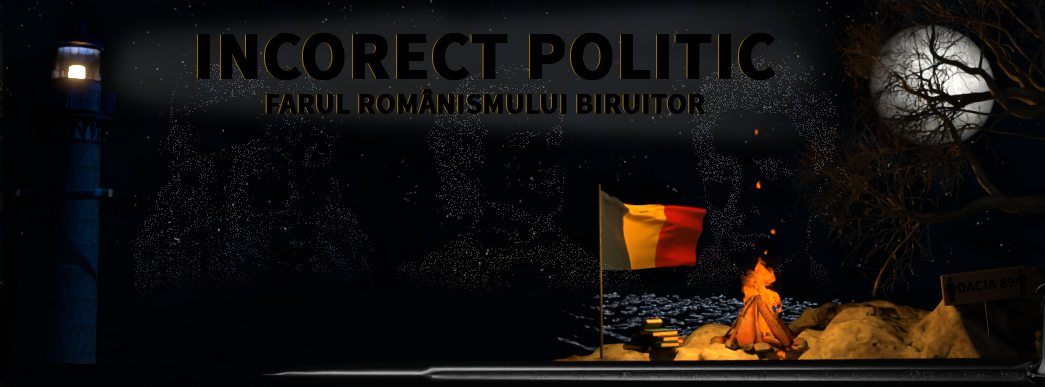 Incorect Politic O Publicație Dizidentă
Incorect Politic O Publicație Dizidentă
